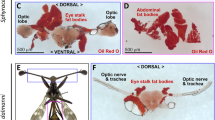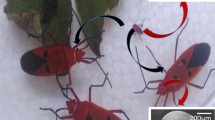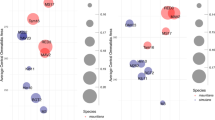Abstract
Diopsid flies have eyes set on stalks which are in some cases so long that the distance between the eyes exceeds the body length. These conspicuous structures have given rise to much speculation about their adaptive value, but there are very few actual observations by which to judge these hypotheses.Cyrtodiopsis whitei Curran lives in the tropical rainforest of Malaysia. We describe a number of aspects of its morphology and biology, some functional properties of the eye, and the ritualized fights between males, by which harems are acquired. The evolutionary significance of the eyestalks is discussed: they represent structures subjected to a double selection pressure; they are an adaptation by which a sensory system is better matched to the special problems encountered in a densely structured habitat (in that the field of view is extended and the ability to estimate distance and size and to identify objects at a large distance is improved), also they act as key stimulus for species recognition and as releaser for intraspecific behaviour.
Similar content being viewed by others
References
Shillito, J.F.: J. Soc. Biblphy. Nat. Hist.3, 337 (1960);8, 65 (1976)
Burkhardt, D., Motte, I. de la: Encycl. Cinematogr. Göttingen, E 2668 (1981)
Burkhardt, D., Motte, I. de la: J. Comp. Physiol. (in press)
Wehner, R., in: The Compound Eye and Vision of Insects, p. 75 (Horridge, G.A., ed.). Oxford: Clarendon 1975
Fuessly, J.G.: Arch. Insekt,1, 6 (1781)
Descamps, M.: Bull. Sci. (Centre Techn. Agricult. Top., Ministère de la France d'Outre-Mer)7, 1 (1957)
Oldroyd, H.: The Natural History of Flies. London: Weidenfeld and Nicolson 1964
Tan, K.B.: Thesis Univ. Malaya, Kuala Lumpur 1965
Burkhardt, D., Darnhofer-Demar, B., Fischer, K.: J. Comp. Physiol.87, 165 (1973)
Wickler, W., Scibt, U.: Z. Tierpsychol.31, 113 (1972)
Burkhardt, D., Motte, I. de la: Encycl. Cinematogr. Göttingen, E 2695 (1982)
Scibt, U.: Z. Tierpsychol.31, 255 (1972)
Burkhardt, D., Motte, I. de la: Encycl. Cinematogr. Göttingen, E 2671 (1980)
Shillito, J.F.: Novit. Zool.42, 147 (1940)
Eggers, F.: Zool. Jb. Syst.49, 469 (1925)
McAlpine, D.K., in: Sexual Selection and Reproductive Competition in Insects, p. 221 (Blum, M.S., Blum, N.A., eds.). London: Academic Press 1979
Hennig, W.: Beitr. Naturkde.145, 1 (1965)
Borgia, G., in: Sexual Selection and Reproductive Competition in Insects, p. 19 (Blum, M.S., Blum, N.A., eds.). New York: Academic Press 1979
Fisher, R.: The Genetical Theory of Natural Selection. New York: Dover 1958
Author information
Authors and Affiliations
Additional information
In Memoriam Karl von Frisch
Rights and permissions
About this article
Cite this article
de la Motte, I., Burkhardt, D. Portrait of an Asian stalk-eyed fly. Naturwissenschaften 70, 451–461 (1983). https://doi.org/10.1007/BF01079611
Received:
Issue Date:
DOI: https://doi.org/10.1007/BF01079611




